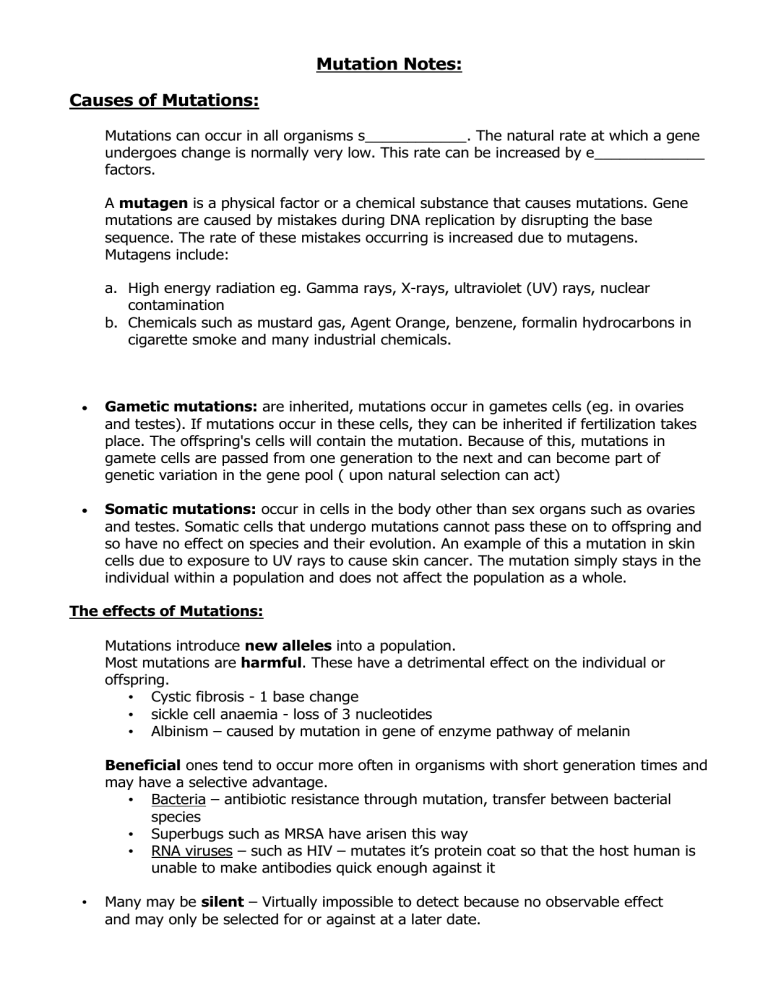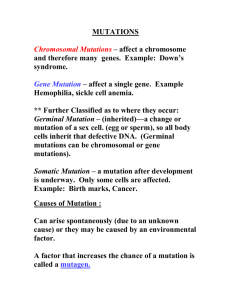File - NCEA Level 2 Biology

Mutation Notes:
Causes of Mutations:
Mutations can occur in all organisms s____________. The natural rate at which a gene undergoes change is normally very low. This rate can be increased by e_____________ factors.
A mutagen is a physical factor or a chemical substance that causes mutations. Gene mutations are caused by mistakes during DNA replication by disrupting the base sequence. The rate of these mistakes occurring is increased due to mutagens.
Mutagens include: a.
High energy radiation eg. Gamma rays, X-rays, ultraviolet (UV) rays, nuclear contamination b.
Chemicals such as mustard gas, Agent Orange, benzene, formalin hydrocarbons in cigarette smoke and many industrial chemicals.
Gametic mutations: are inherited, mutations occur in gametes cells (eg. in ovaries and testes). If mutations occur in these cells, they can be inherited if fertilization takes place. The offspring's cells will contain the mutation. Because of this, mutations in gamete cells are passed from one generation to the next and can become part of genetic variation in the gene pool ( upon natural selection can act)
Somatic mutations: occur in cells in the body other than sex organs such as ovaries and testes. Somatic cells that undergo mutations cannot pass these on to offspring and so have no effect on species and their evolution. An example of this a mutation in skin cells due to exposure to UV rays to cause skin cancer. The mutation simply stays in the individual within a population and does not affect the population as a whole.
The effects of Mutations:
Mutations introduce new alleles into a population.
Most mutations are harmful. These have a detrimental effect on the individual or offspring.
• Cystic fibrosis - 1 base change
• sickle cell anaemia - loss of 3 nucleotides
• Albinism – caused by mutation in gene of enzyme pathway of melanin
Beneficial ones tend to occur more often in organisms with short generation times and may have a selective advantage.
• Bacteria – antibiotic resistance through mutation, transfer between bacterial species
• Superbugs such as MRSA have arisen this way
• RNA viruses – such as HIV – mutates it’s protein coat so that the host human is unable to make antibodies quick enough against it
• Many may be silent – Virtually impossible to detect because no observable effect and may only be selected for or against at a later date.
• Neutral mutations make no change at all.
but may be important in an evolutionary sense
Types of mutations:
Neither harmful or beneficial to the organism
During replication, mistakes can be made in the copying process. This can result in an altered sequence of DNA bases and the formation of an alternative allele of a gene.
These gene mutations can be of 3 types: a substitution mutation, a deletion mutation and an insertion mutation. If the mutation only involves one nucleotide they are called point mutations. Insertion and deletions usually cause major changes in the amino acid sequence of the protein.
Chromosome mutations: during meiosis chromosomes can break apart and recombine in ways that cause genes to be arranged in new sequences often causes severely harmful effects:
Classified into four types:
Deletion - where part of a chromosome breaks off and a gene is effectively lost from the chromosome eg. Crit-du-Chat syndrome (a deletion occurs in a chromosome from pair 5);
Duplication - where the same section of a chromosome is copied or repeated and occurs twice. In some cases a piece of a chromosome may break off and join onto other chromosome of the homologous pair;
Inversion - where the order of the genes is reversed. This can occur due to part of a chromosome breaking off, rotates 180 0 and then rejoining in the opposite direction; The gene will be in reverse order for this segment of the chromosome.
Translocation - where a part of one chromosome breaks off and migrates to another chromosome where it becomes attached eg. breakages in chromosomes 15 and 21 can result in Down syndrome.
CHROMOSOME MUTATIONS
These can only occur during meiosis . a.k.a. Block mutations .
Deletion :
Inversion :
Examples:
Cru-Du-Chat, Prader-Willi
Examples:
On chromosome 2
– unviable offspring
Translocation :
A section of one chromosome is lost to another one
Duplication :
A section of one chromosome is lost to its Homologue
Chromosomes 9 and 22
– chronic leukaemia
Page 149/50
Whole Chromosomal mutations occur during meiosis as a result of homologous pairs of chromosomes not separating during the first division. This is called non-disjunction and results in some gametes with extra chromosomes and others with less than the normal number. A whole chromosome, or whole set of chromosomes are added or lost.
Will have dire consequences.
Trisomy An example of this in humans is Down syndrome. During meiosis, the two number 21 chromosomes (usually in the mother) do not separate and the resulting ovum contains two number 21 chromosomes instead of just one, with a total of 24 instead of the normal haploid number of 23. When this ovum is fertilized by a normal haploid sperm with one number 21 chromosome (total 23), the resulting zygote is a
trisomy and will have three number 21 chromosomes (total of 47 instead of the normal diploid number of 46). Down syndrome is also called trisomy-21 as there are three number 21 homologous chromosomes.
Another example of trisomy in humans is Klinefelter’s syndrome (XXY) where the ovum has two x chromosomes and is fertilized by a normal sperm with one Y.
Polyploidy is the result of a diploid (2N) gamete being fertilized by a haploid (N) gamete to produce a triploid (3N) zygote, or even two diploid gametes producing a tetraploid (4N) zygote. These types of chromosomal non-disjunctions are the result of all homologous chromosomes not separating during meiosis with one gamete having all
(2N) chromosomes and the others having none.
Polyploidy is common in plants such as modern hybrid bread wheat ( Triticum aestivum) which has 6N number of chromosomes. In the weed Datura stramonium, the trisomic effect can be detected by the phenotypes of the seed capsule such as rolled, elongate, globe. Many garden flowering plants such as tulips and daffodils are polyploids and they mainly reproduce asexually by bulbs.









